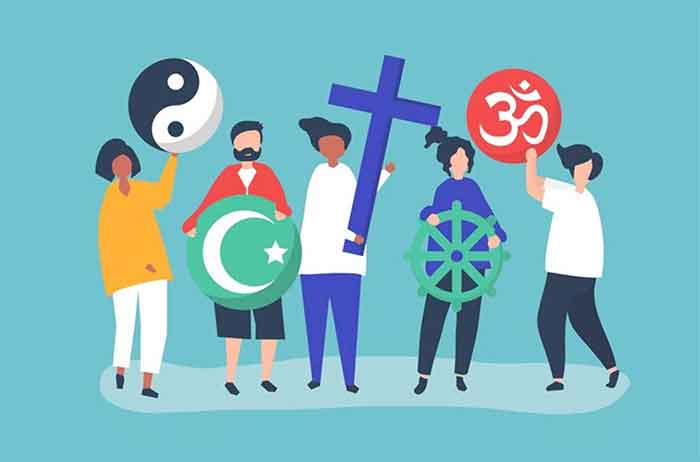
Introduction
India is a subcontinent with vast and tremendous diversity. It’s a hotspot for individuals from distinct cultures, castes, religions, tribes, and languages. However, this diversity has been seen as a cradle of unity in India, ‘unity in diversity’. Regardless of this, it has been also an ultimatum for the country since the advent of right-wing politics in India. Therefore, to build a harmonious and united nation, India must incorporate and inculcate the inclination in its people to accept the compliances to diversity and foster harmony among its citizens.
Harmony in India through Historical Context
The history of the Indian subcontinent, at all times, demonstrated solidarity and communal cohesion since a long time. The inception of this consolidation and communal harmony was coined for the first time by Well-reckoned Muslim Scholar, historian and jurist, Ibn Khaldun, the author of masterpiece, ‘Al-Muqaddima.[i] This perception was later implemented comprehensively during Mughal rule. The empire is an evident and exemplary model which ever fostered religious pluralism and has always been known to be a tolerant society. The Mughals ruled over a vast and tremendous region which comprised people from numerous backgrounds, religions and cultures. They deliberately maintained the peace and stability in the region, promoting religious tolerance and mutual understanding. The reign of Akbar is quite apparent and obvious how he treated all the citizens of his kingdom as equal, irrespective of their religious backgrounds. Regardless of what Islam implies, he coined the ‘Deen-i Ilahi’ concept to shatter the barriers prevailed among Muslims and Hindus in kingdom and the contemporaneous cabinet ministers in his royal authority.[ii] This reign of Mughal Empire is a spectacular time ever to witness the paramount of religious harmony throughout the Indian history.
Another splendid memory of ‘unity in diversity’ and interfaith dialogue is relevant in the Indian Independence movement. The movement against Englishmen was a broad coalition and a massive alliance of people from different religions, castes and classes. They left never a dearth to stay united against the British-raj as they shared a common goal of independence.
Caste discrimination- The Menace in Indian Society
However, in this 21st century, there are numerous challenges to nation building widespread in many of the corners of the country. One of the most insidious and notorious one of those is the persistence of caste discrimination. Caste discrimination is the worst form of social inequality that has been practiced and become a custom in many pastoral regions in India for centuries. This system led to poverty, illiteracy, and social exclusion for millions of Indians. As a result, social disparity often form the communal violence over a period of time. The violence of Meitei groups against the Kukis is the deadliest violence ever in the Indian history since the independence. The sexual assault of the two Kuki women and their nude parade intimidation by Meiteis is the most gruelling and disgraceful communal hate ever to witness in a country like India.[iii] Another gruesome communal hatred is witnessed in Maharastra’s ‘Nanded’ district where 21-year-old Akshay Shravan Bhalerao was murdered by Some Brahmin MLA’s partymen for mere celebration of Ambedkar Jayanti.[iv]
Religious extremism-Spewing communal venom
Another challenge to nation building in India is the surge of religious extremism. In the recent years, India has witnessed the most gruelling and nauseating escalation of religious violence. The most famous democracy of the world transformed into the ‘bulldozer democracy’ nowadays. The dreadful murder of 22 years old Maulana Muhammad Sa’ad in Nuh district[v], the mass obliteration of 700 plus houses in it[vi], the ferocious attack of Chetan Singh upon three Muslim Maulanas in the Jaipur-Mumbai train incident[vii], the issue of Gyanvapi mosque are the apparent instances of religious intimidation[viii]. However the poignant matter is that these cases are often understated by media for paltry TRPs, and the right wing ruling authorities when it deems to be an ultimatum for them to handle. The glib phrases of political leaders to foster the harmony and create a peaceful society in the inception of their tenure are of no worth to cope the violence when it deteriorates the environment and looms to move to a gigantic turn. As a result, religious violence tears apart the fabric of Indian society, making it harder to develop a strong and united nation.
Despite the challenges, there’re also many reasons to be optimistic to prognosticate a better future for India. According to World Population Prospects, India has over 50 percent young and vivacious population in the age group of 18-25 with a growing economy[ix]. On the other hand, there are millions of Indian citizens who are resilient and have a strong sense of ‘we feeling’ and national consolidation. With joint effort of citizens, India can overcome its challenges and build a strong and united nation that embraces its diversity and fosters harmony among its citizens.
Education-The Panacea for all Nuisances
There are certain factors which might be significant to foster harmony among the people. Initially India has to ensure the proper education and awareness about different cultures and religions among the sedentary citizens as common and pastoral citizens as specific. When people come to know about the reality of different cultures and religions, and hold in-depth knowledge about them, they are less likely to spew pessimistic perceptions about the people from those cultures and religions. This can lend a hand to assimilate the religious tolerance and mutual understanding in the society.
The Need of Interfaith dialogue
In addition to that, when people empathize each other’s cultures and religions, they are more likely to work together and cooperate each other to pull off in attaining their common goals. This might culminate to the advent of a cohesive society throughout the subcontinent. The implementation of this method can be carried out by incorporating cultural and religious diversity in school curriculum. This might work out if we teach students about the diverse religions, their customs and their cultures. It is as also pivotal to teach them about the importance of tolerance and mutual understanding as teaching them about it. Schools and colleges can organize interfaith events and discussions. This can be an effective way to exterminate the religious and cultural disparities prevalent among the alumnus. It is also vital to create an innocuous space where students can feel comfortable to share their thoughts and instincts. Thus, the interfaith dialogue can help to diminish the discriminations, prejudices and communal venoms which are often spewed by the right-wing political leaders.
Monitoring Equality Policies
On the other hand, India can monitor and enact the policies of equality and social justice, postulated by the constitution of India in the article 14, 15, 16, 17, 38, and 46, meticulously to ensure the equality among all its citizens in all aspects of their life as well as ensuring the abolition of discrimination on the basis of caste, religion, sex, race or any other background. Thus, it would be an effective way to protect the intimidated sects like Kukis and Dalits from the discrimination and the communal violence they are confronting. Furthermore, the ruling authorities often occupy supremacy over many regions in India that deems to be a challenge for the minorities to deal. Therefore, India has to scrutinize the execution of ‘Affirmative Action for Women and Minorities’ policies which are designed to empower the minorities. This would ensure the inclusion of quotas and reservations for minorities in education and employment. Moreover, certain drives to promote the fiscal progress of the minorities can also bolster their confidence to grow up.
Conclusion
The holistic insights elaborated here culminates that India is an ideal nation which possesses vast diversity among its people. This diversity can be a pivotal reason for both convictions and harmony among the societies. The moot factor here is to blend our postures towards the optimistic perceptions instead of the pessimistic ones. And diminish fissiparous tendencies to eliminate the prejudices against the differences prevalent among us. We must, likewise, leave no stone unturned to utilize this diversity as a source of a strength and an asset. Because, when people unite together from different backgrounds, they can share their ideas and insights which would lead to modernistic and innovative solutions to problems. As a result we might succeed to embrace this diversity and foster harmony to build a better, strong, and a united nation. In fact, diversity is the mere beauty of a nation which brings a sense of pride for it. India is a country with a rich and diverse cultural heritage which reflects in its art, music, dance, literature, customs, and celebrations. This diversity is what makes India distinctive and special.
Toufik Imrose Khaledy is a Degree Final Year Student of Department of Fiqh & Usul Al-Fiqh at Darul Huda Islamic University, Chemmad-Kerala. He is the author of the book, ‘ANALYSIS OF WOMEN’S CHARACTER IN ROMEO AND JULIET AND OTHELLO’ published by Notion Press (ISBN-9781647330477). The book is available on Amazon, Flipkart and on ‘Barnes & Noble’, ‘Adlibris’ and ‘Takealot’ sites for purchase outside India.
Email: [email protected]
References
[i] Ab Halim, A. (2014). Ibn Khaldun’s theory of ‘Asabiyyah and the concept of Muslim Ummah. December 12, 2016
[ii] Dr. Anwarsyah Nur, The Contribution of Dīn-I-Ilāhī Towards The Life And Culture, P-88, 4th International Conference the Community Development in ASEAN, 2017
[iii] Women’s bodies, disinformation and nationalism in Manipur, Laxmi Murthy, Himal-South Asian August 7, 2023
[iv] Bleeding blue in Nanded | Where celebrating Ambedkar’s birthday is a crime, Abhinay Deshpande/The Hindu, June-17, 2023
[v] Shops burnt, imam killed, mosque torched — how Nuh clashes spawned targeted violence in Gurugram, Bismee Taskin/The Print, August-1, 2023
[vi] Nuh violence: 1,208 structures razed by Haryana govt, mostly of 1 community, Leena Dhankar/Hindustan TimesAugust-10, 2023
[vii] Indian guard kills colleague and three passengers on train, then hails Modi, Aljazeera, July-31, 2023
[viii] Hindu side seeking entry into Gyanvapi mosque by illegitimate means, Supreme Court told, India Today, July-23, 2023
[ix] Youth in India/Wikipedia https://en.wikipedia.org/wiki/Youth_in_India














































